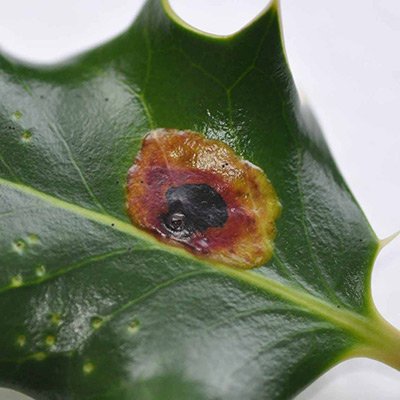
 |
|
Scientific Classifications explained » Amphibians » Ants » Aphids » Bees » Beetles » Birds » Bugs » Butterflies » Caterpillars » Damselflies » Dragonflies » Earwigs » Flies » Frog/Leafhoppers » Fungi » Galls » Grasshoppers » Harvestmen » Hoverflies » Lacewings » Ladybirds » Leaf Mines » Lichens » Mammals » Millipedes » Mosses » Moths » Sawflies » Slugs » Snails » Spiders » Trees & Shrubs » Wasps » Wild Flowers » Woodlice » Postboxes |
UK Nature > Leaf MInes > Phytomyza ilicis

Gall causer: Phytomyza ilicis Common Name: Holly Leaf Miner Phytomyza ilicis, the holly leaf miner, is a fly whose larvae burrow into leaves of the holly tree, Ilex aquifolium, leaving characteristic pale trails or leaf mines. The holly leaf miner has frequently been used in ecological studies as a system to study food webs since examination of the leaves can reveal whether the leaf miner has successfully emerged, been killed by a parasitic wasp, or been predated by blue tits. Female flies insert an egg in the leaf tissue using an ovipositor. In the case of Phytomyza ilicis this poses a problem, because the leaf of the hostplant is unusually tough. Only during the annual flush in April, May, when new leaves unfold, oviposition is possible. Oviposition is in the underside of the petiole, or the basal part of the midrib. Oviposition induces the formation of a characteristic oviposition scar, enabling an estimate of the number of eggs that has been deposited. The emerging larva tunnels within the midrib, in the direction of the leaf tip. Only around January it enters the leaf blade, and starts making a recognisable leaf mine. Up to three mines may occur on a leaf - often much less than the number of oviposition scars, suggesting that intra-leaf competition has taken place. The adult emerges in late May or June and leaves a >1 mm emergence hole (exit holes made by parasitoids are much smaller). The holly leaf miner is common and widespread, found throughout the UK on its host. |
|

https://www.uknature.co.uk is a website dedicated to showing the immense diversity of UK nature and wildlife. Our vast range of habitats, from lowland arable to snow covered mountains, from storm-ravaged coastlines to peaceful inland freshwater lakes and rivers, from dry, sandy heaths to deciduous and coniferous forests, all these habitats contribute to the abundance of UK nature. We have wild birds in huge numbers either residing or visiting our shores (597 recorded species as at July 2013) and we must also not forget the humble back garden with its grass lawns, flower beds filled with nectar rich flowers, shrubs and trees, all designed to attract huge numbers of insects such as bees, moths, butterflies and hoverflies; and finally the small ponds which provide safe havens for frogs, toads, newts and even slow worms and grass snakes. www.uknature.co.uk is the showcase for my personal passion, photographing uknature in all its glory. I sincerely hope you all enjoy the fruits of my labours. This site and all images contained therein is © Jeremy Lee 2004 - 2025. All Rights Reserved. Site design by Jeremy Lee. Site development & IT Support by Stuart Lee. |